It and I* caused a crowd to gather
After we’d hiked most of the way back down from the main dome at Enchanted Rock on April 12th, Eve called my attention to a brightly colored lizard the likes of which I don’t recall ever seeing before. I put the 100–400mm lens on my camera, zoomed all the way out, and began to take pictures, gradually moving closer, never knowing when the lizard would dart away. This was along the main trail, so quite a few people passed by, and as they did, more and more of them stopped to see what I was photographing. Once they spotted my subject they were taken, as I of course was, with the lizard’s saturated blue. In all, probably between one and two dozen people had gathered round.
Back home later I searched for an identification and found that this seems to have been a male common collared lizard, Crotaphytus collaris.
* The phrases he and I, she and I, and you and I are common. They and I occurs less often, generally replaced by we. The it and I in this post’s title, though perfectly grammatical, seems strange, probably because of the clash between it, which usually refers to non-human and mostly inanimate things, and I, which is the most personal of personal pronouns. It and you, it and we, it and he, it and she, and it and they also sound somewhat strange, don’t you think?
© 2021 Steven Schwartzman

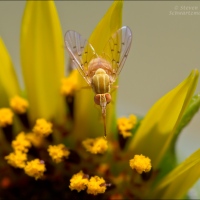
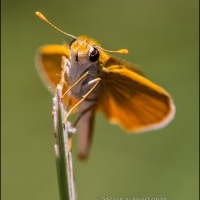
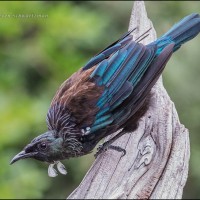
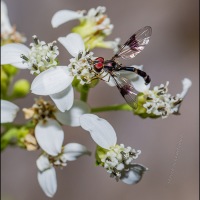
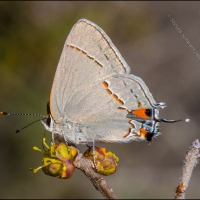
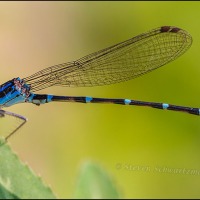

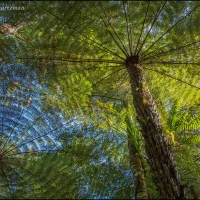

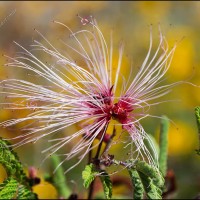
i’ve never seen one with this coloring before – amazing to me
beth
May 6, 2021 at 4:39 AM
As it was to us and the people who gathered round.
Steve Schwartzman
May 6, 2021 at 6:59 AM
Fabulous color and texture. I especially like the little splash of red.
Lemony
May 6, 2021 at 6:23 AM
That little bit of contrasting red made me wonder if it serves some purpose.
Steve Schwartzman
May 6, 2021 at 7:03 AM
Yes, I wondered the same thing. It is certainly signaling *something.* In some female lizards red dots can indicate a gravid state, but you have identified this one as male, so it’s obviously something else in his case.
Lemony
May 6, 2021 at 8:14 AM
From what I read online, I did take this one to be a male. Of course I know almost nothing about lizards, so I could be wrong.
Steve Schwartzman
May 6, 2021 at 2:48 PM
These are what we call “mountain boomers” in Oklahoma! They are commonly seen in the Wichita Mountain Wildlife Refuge area near Lawton. They can be excellent posers, not particularly put off by observers at close range. What a handsome specimen you captured. It’s a stunner, for sure!
Littlesundog
May 6, 2021 at 7:14 AM
Now that’s a descriptive name: mountain boomers. Do they really make a booming sound? I found your observation to be true: this lizard was an excellent poser and didn’t get bothered till I got pretty close. Even when it scurried away it didn’t go far, and I was able to re-approach and take more pictures. By coincidence, this morning I found and photographed another one an hour west of Austin.
Steve Schwartzman
May 6, 2021 at 6:18 PM
Beautiful specimen and photo execution. I have a difficult time referring to animals as “it”. in Portuguese, lizard is a guy unless you know it’s a girl. “It and I“ does sound strange. Interesting English lesson.
Alessandra Chaves
May 6, 2021 at 7:20 AM
Thanks. That blue really was an eye-grabber, and the pale orange of the granite did a good job bringing it out.
I understand how the two genders in Portuguese, masculine and feminine, make it hard for you to refer to an animal as “it.” Even in English it can be complicated. The other day I came across a reference to “birds who…,” which I wouldn’t say because I reserve “who” for humans.
Steve Schwartzman
May 6, 2021 at 6:27 PM
LOL it’s really complicated! When I refer to an animal as “it” I feel like I’m diminishing it! “Birds who” is funny. I don’t think even I would say that, unless I was not paying attention, which does happen.
Alessandra Chaves
May 6, 2021 at 7:48 PM
It was common when I was growing up to use “it” even for human infants, presumably because they don’t yet look like one sex or another.
Steve Schwartzman
May 6, 2021 at 9:24 PM
It’s stunning! I would have stopped to look too!
In France, they use the pronoun “on” ohn for it, he and she. I like using the word one a lot in place of it. I think it’s going out of favor though in English.
circadianreflections
May 6, 2021 at 8:37 AM
I’ll bet you would have stopped. I found another one this morning and of course stopped to take more pictures.
One would agree that that kind of one is now formal and may well be on its way out of the modern language, increasingly replaced by you.
Steve Schwartzman
May 6, 2021 at 6:31 PM
If you had not been taking pictures of this colourful lizard the crowd would have walked past you without even noticing it.
Peter Klopp
May 6, 2021 at 8:57 AM
I think you’re right. I don’t know that I would have seen it, either, but Eve had walked ahead and she told me about it when I caught up to her. She often serves as a scout because I lag behind a lot because I frequently stop to take pictures.
Steve Schwartzman
May 6, 2021 at 6:34 PM
Good spotting! 🙂
Pit
May 6, 2021 at 9:29 AM
Both of the lizard and on the lizard.
Steve Schwartzman
May 6, 2021 at 6:35 PM
Beautiful colours!
Anabel @ The Glasgow Gallivanter
May 6, 2021 at 10:35 AM
Who knew we have such a colorful lizard in central Texas?
Steve Schwartzman
May 6, 2021 at 6:37 PM
Wow–what a critter! He/she/it/they/them is very beautiful!
Tina
May 6, 2021 at 12:11 PM
What a critter indeed. How had I missed seeing one all these years? I made up for it by finding another one this morning at Inks Lake.
Steve Schwartzman
May 6, 2021 at 6:40 PM
A realy colorful guy it is 🙂
picpholio
May 6, 2021 at 12:55 PM
That’s for sure. I was a welcome find.
Steve Schwartzman
May 6, 2021 at 6:41 PM
Very snappy dresser, and looks comfortable posing for the camera. What a great color.
Robert Parker
May 6, 2021 at 1:27 PM
A snappier dresser than I’ll ever be. Fortunately almost all my time posing is behind the camera.
Steve Schwartzman
May 6, 2021 at 6:42 PM
A beauty indeed – wish we had some of those here…
Leya
May 6, 2021 at 3:46 PM
Alas, it couldn’t survive in chilly Sweden. In contrast, the Texas heat doesn’t faze it.
Steve Schwartzman
May 6, 2021 at 6:44 PM
Fantastic Steve! I’ve shared on twitter at https://twitter.com/ExploringColour/status/1390462823340265479 and I found a lovely web page with extra info and a neat pic – shows bright orange right down the underside of the neck! At: https://www.wildlifedepartment.com/wildlife/nongamespecies/reptiles/eastern-collared-lizard
Ms. Liz
May 6, 2021 at 7:30 PM
Thanks for disseminating this post, Liz. An earlier commenter from Oklahoma mentioned the name mountain boomer, and the page in your second link mentions that this species is the Oklahoma state lizard. It’s easy to see why the lizard’s colors would have won it that honorary place. The orange head in the photograph there is quite something, a great contrast to the mostly blue body. I’m so unfamiliar with this lizard that I don’t know if an individual’s head color changes with age or if there’s a natural variation in head color across the species.
Steve Schwartzman
May 6, 2021 at 9:06 PM
A turquoise beauty – well caught, Steve!
Eliza Waters
May 6, 2021 at 7:40 PM
Good for you for identifying the color as turquoise. Imagine one of these lizards camouflaged on actual turquoise.
Steve Schwartzman
May 6, 2021 at 9:08 PM
‘It and I’ sounds strange? I suppose so. I often refer to trees that I work with as ‘he’. I do not know why. Perhaps it is because that is how the Italian, French and Spanish languages work. Clients find it amusing.
tonytomeo
May 6, 2021 at 7:51 PM
If you ever visit Portugal or Brazil you’ll have to start saying ‘she’ because árvore is feminine in Portuguese. If you visit Russia you’ll have to say, like most English speakers, ‘it’ because Russian дерево is neuter.
Steve Schwartzman
May 6, 2021 at 9:19 PM
French seem to use ‘she’ for it also. It sounds sexist to me.
tonytomeo
May 7, 2021 at 12:54 AM
Actually arbre is masculine in French. The word is identical and also masculine in Catalan.
Steve Schwartzman
May 7, 2021 at 5:13 AM
But that is ‘tree’, not ‘it’. I know only ‘il’ or elle’ for it.
tonytomeo
May 8, 2021 at 2:03 AM
If I had been there, I would also have joined you and it, Steve, making it we and it.
tanjabrittonwriter
May 6, 2021 at 9:46 PM
Now that’s the way to talk. It and we would’ve made for good company.
Steve Schwartzman
May 6, 2021 at 9:50 PM
It’s a beautiful lizard. The bluish bits of lichen on the rocks coordinate nicely with its color. I’m not sure if it’s true for this species, but I found this interesting tidbit:
“Collared lizards are often parasitized by larval chigger mites (the same ones that bite us humans). Chiggers feed on cellular cytoplasm and not blood, but they are naturally reddish in color. They also tend to congregate in areas where the lizard’s scales are small and thin, such as behind the shoulder, forming distinctive red patches.” You mentioned chiggers being out and about now; perhaps that’s the explanation for the red spot.
shoreacres
May 6, 2021 at 10:21 PM
That kind of lichen densely covers some of the rocks at Enchanted Rock, so you’ve made me imagine a common collared lizard on one of those surfaces. Not that I’m complaining: the pale orange of the granite creates a pleasing contrast with the lizard’s turquoise.
Thanks for the possible explanation of mites as the cause of the red spot, which somehow reminded me of the great red spot on Jupiter.
Steve Schwartzman
May 7, 2021 at 5:22 AM
Wow! That’s some beautiful coloration, and I certainly see why it caught your eye. Great job photographing it. I also find it fascinating in situations like this how many folks might walk by and never see this, but with you having seen it first, they now have the opportunity to see it, as well.
Todd Henson
May 9, 2021 at 6:34 PM
I might not have seen it, either, but Eve had noticed it and called my attention to it once I caught up to her. You’re right that plenty of other people benefited. I took a bunch of pictures, with more than this one coming out well. And this past week at a different state park I got a second chance to photograph this species. After never having seen one over my four decades in Texas, lightning struck twice in less than a month.
Steve Schwartzman
May 9, 2021 at 8:30 PM
Crotaphytus collaris is a very striking lizard.
Lavinia Ross
May 10, 2021 at 10:34 AM
It sure is, and the reason I took so many pictures of it.
Steve Schwartzman
May 10, 2021 at 11:50 AM